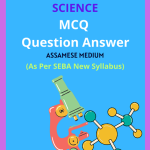Class 7 Science MCQ Chapter 6 Physical and Chemical Exercise Solutions in English Medium, Class 7 Science Multiple Choice Question Answer in English to each chapter is provided in the list so that you can easily browse throughout different chapters Class 7 Science MCQ Chapter 6 Physical and Chemical Exercise Notes and select need one.
Class 7 Science MCQ Chapter 6 Physical and Chemical Exercise
Also, you can read the SCERT book online in these sections Class 7 Science Objective Type Solutions by Expert Teachers as per SCERT (CBSE) Book guidelines. These solutions are part of SCERT All Subject Solutions. Here we have given Assam Class 7 Science MCQs Solutions in English for All Subject, You can practice these here.
Physical and Chemical Exercise
Chapter – 6
| MCQ |
1. The layer of rust is actually deposit of:
(a) Iron (III) oxide.
(b) Mud.
(c) Water.
(d) Oxygen.
Ans: (a) Iron(III) oxide.
2. What happens when vinegar reacts with baking soda?
(a) Formation of water.
(b) Formation of carbon dioxide.
(c) Formation of hydrogen gas.
(d) Formation of oxygen gas.
Ans: (b) Formation of carbon dioxide.
3. Which of the following is not a chemical change?
(a) Burning of coal.
(b) Digestion of food.
(c) Melting of ice.
(d) Rusting of iron.
Ans: (c) Melting of ice.
4. Which of the following is not a physical change?
(a) Melting of wax.
(b) Tearing a piece of paper.
(c) Dissolution of salt in water.
(d) Digestion of food.
Ans: (d) Digestion of food.
5. Which of the following is a chemical change?
(a) Breaking of a brick.
(b) Evaporation of a liquid.
(c) Burning of a candle.
(d) Moving of a wheel.
Ans: (c) Burning of a candle.
6. What will happen to red litmus paper when tested with the aqueous solution formed by mixing ash with water?
(a) It will turn red.
(b) It will turn blue.
(c) It will remain red.
(d) It will become colourless.
Ans: (b) It will turn blue.
7. Which of the following is a physical change?
(a) Glowing of an electric bulb.
(b) Formation of curd from milk.
(c) Cooking of food.
(d) Growth of a plant.
Ans: (a) Glowing of an electric bulb.
8. Which of the following is a physical change?
(a) Rusting of iron.
(b) Burning of wood.
(c) Melting of ice.
(d) Souring of milk.
Ans: (c) Melting of ice.
9. In which type of change a new substance is formed?
(a) physical change
(b) chemical change
(c) both in physical and chemical change
(d) none of the above
Ans: (b) Chemical change.
10. The process of depositing a layer of zinc on iron is called ____ ?
(a) Galvanisation.
(b) Crystallisation.
(c) All of the above.
(d) None of the above.
Ans. (a) Galvanisation.
11. What is a chemical change also called?
(a) Physical change.
(b) Chemical reaction.
(c) Mechanical change.
(d) Biological reaction.
Ans: (b) Chemical reaction.
12. What happens to iron in the presence of moisture and oxygen?
(a) It melts.
(b) It rusts.
(c) It becomes shiny.
(d) It breaks.
Ans: (b) It rusts.
13. Which of the following is NOT a common indicator of a chemical change?
(a) Heat production.
(b) Colour change.
(c) Change in taste.
(d) Gas formation.
Ans: (c) Change in taste.
14. What is always produced during the burning of any substance?
(a) A new smell.
(b) Light.
(c) Heat.
(d) Sound.
Ans: (c) Heat.
15. A change in which one or more new substances are formed is called a _________ change.
(a) Magnesium oxide.
(b) Physical change.
(c) Chemical reaction.
(d) None of the above.
Ans: (c) Chemical reaction.

Hi! my Name is Parimal Roy. I have completed my Bachelor’s degree in Philosophy (B.A.) from Silapathar General College. Currently, I am working as an HR Manager at Dev Library. It is a website that provides study materials for students from Class 3 to 12, including SCERT and NCERT notes. It also offers resources for BA, B.Com, B.Sc, and Computer Science, along with postgraduate notes. Besides study materials, the website has novels, eBooks, health and finance articles, biographies, quotes, and more.



